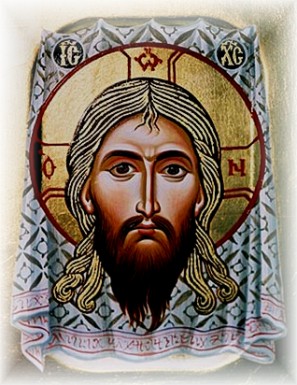 Early History of Icons Early History of Icons
Eusebius of Caesarea, the first prominent Church historian, relates that the miraculous image of the face of Jesus
on a cloth (the Mandylion) sent to King Abgar of Edessa by Christ Himself was the first true icon. This, along with the image of Christ
imprinted on the Veil of Veronica as He passed her on the way to the Crucifixion and the
image on the burial cloth (the Holy Shroud of Turin), constitute the main acheiropoieta (not-made-by-hands) images of Christ.
Church tradition records that the first icons of the Mother of God were written
by St. Luke the Evangelist who is considered the first iconographer in the Church. While the exact number of the icons of St. Luke are
debated (three, seven and seventy being proposed), the icon later know as 'Hodigitria' (she who shows the way) has a traceable history from Luke's friend Theolphilus to the Byzantine Church of Blachernae in Constantinople.
Eusebius also writes of seeing paintings identified as images of the early apostles in existence in the 4th century. As new saints were added to the church strict rules on how the icon of the saint was to be written were formulated. This accounts for the uniformity of icons of individual saints throughout history.


|